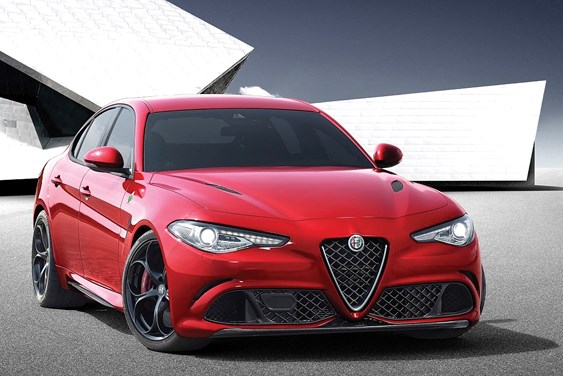In person, the new Alfa Romeo Giulia sedan looks great.
Pictures don’t do it justice: in person, sheetmetal that looks a little overwrought in photos seems to smooth out, and the signature triangular grille looks less awkward. Alfa Romeo is back.
The question becomes, so what? Do we really need yet another car brand? BMW and Mercedes already offer everything from hybrid supercars like the i8 to anachronistic battle tanks like the Gelandewagen. The Germans have left no niche unfilled.
In the immortal words of Homer Simpson, Alfa finds itself in the position of trying to cram one more salty treat into America’s already bloated snack hole. Or car hole, as the case may be. We’re already up to our eyeballs in leased models of the 3 Series and C-Class, why do we need another (probably less reliable) four-door?
The first argument made is that the Giulia is flippin’ great. The Quadrofoglio model, Alfa’s answer to the M3 or C63 AMG, is faster and more flavourful than either. Its twin-turbo V-6 is one of the best-sounding sixes on the market, cranking out 505 horsepower and basically proving itself worthy of being fitted into a Ferrari. Partially, that’s because it’s essentially a cousin of the F488’s twin-turbo V-8.
Then there’s the quick steering and lively chassis, and details like the carbon fibre hood. You can see the edge of this last as you peer out over the steering wheel in the Giulia’s somewhat cramped cabin. Even if you opt for the 280 h.p. turbo-four, Alfa’s return feels like a triumph. It’s not as good at the tech or infotainment game as the German competition, but as a driver’s car with an injection of style, it’s lovely.
Whipping through the chicanes at the back of Sonoma raceways, I experienced a singular feeling of relief. Exhilaration was there as well, but finding that the Giulia was worthy of its Alfa badge was more a weight off the shoulders than a fire in the belly. The little 4C, which is pitched as a competitor to the Porsche Cayman, had any number of dynamic quirks, signaling the potential for the Giulia to lack that certain Alfa-Romeo spark.
The weight of history behind Alfa’s badge is staggering. More than 100 years ago, the Anonima Lombarda Fabbrica Automobili company began producing lightweight machines, entering into racing almost immediately with the 1911 Targa Florio. A few years later, entrepreneur Nicola Romeo gained control of the company, which changed to materiel production during the First World War.
After the war, Alfa Romeo emerged with the Torpedo 20-30 h.p., with racing successes coming at the beginning of the 1920s thanks in part to a young driver named Eno Ferrari. That’s right, Ferrari’s founder got his first job racing Alfa Romeos.
In 1925, at the height of the roaring ‘20s, an Alfa Romeo P2 won the very first world Grand Prix championship. In 1935, Tazio Nuvolari drove an Alfa Romeo to victory at the German grand prix in front of the faster, more powerful Silver Arrows team. In what is surely the greatest victory in motor racing, the outdated and underpowered Alfa trounced the state-backed propaganda machines right in front of the Nazi elite. In 1950, an Alfa Romeo won the very first Formula One series. It won the next year too.
Take all this racing success and distill it into light and lively road cars, ethereal little machines like the red Spider 1600 Duetto driven by Dustin Hoffman in The Graduate. Probably my favourite of the recent-classic Alfas is the delicious 2000 GT Veloce (GTV), which has got to be one of the best looking Italian machines within the realm of a reasonable budget.
And yet somehow, as the decades progressed, Alfa Romeo lost its way. There was esoteric madness like the Procar, which was essentially a sedan body on a V-10 powered Formula One car, and touring car racing, but a reputation for unreliability began to dry up Alfa’s appeal.
By the late 1990s, Alfa was only a memory, fondly thought of by the Alfisti, but overlooked by most. With the rise of the crossover in sales importance, cars got bigger, heavier, taller. You could still get an Alfa Romeo in Europe, but here only the hardcore fans remain.
But now it’s back, snatching bragging rights away from Porsche as the fastest four-door around the Nürburgring, and generally being a riot to drive. There are complaints to be made – no manual transmission in the North American market, even in sporting trims – but on the whole, the Giulia is exactly what Alfa fans were hoping for.
On the winding, hilly roads around Napa, I flicked the left-most column-mounted paddle-shifter (exactly like you get in a Lamborghini Huracan), dropped a gear or two, and let the turbos spool up. I’m not sure the Germans need to worry about Alfa Romeo suddenly stealing the sales charts, and I’m positive this car isn’t going to work for everyone.
But as the Giulia shrinks around me and the road beckons onwards, it’s good to have Alfa Romeo back. We didn’t know we need them, but we do.
Brendan McAleer is a freelance writer and automotive enthusiast. If you have a suggestion for a column, or would be interested in having your car club featured, please contact him at [email protected]. Follow Brendan on Twitter: @brendan_mcaleer.



